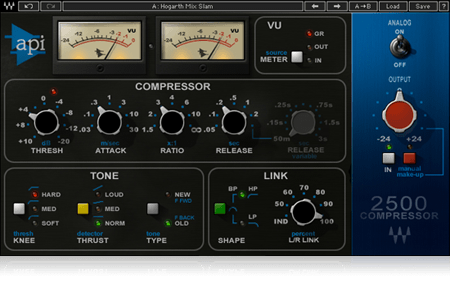
Reader Mail: Buss Compression
I’ve got another question today in response to my Any Questions? post:
Can you recommend some good Venue pluggins[sic] for compressing you L/R output Bus and how much compression you typically add to your mains (also do you add any make up gain?
Personally, I’m not using any master buss compression right now, and I’ve gone back and forth on using it for live sound. It’s pretty standard for me if I’m in the studio, and I was using it pretty regularly in the live realm up until a few months ago when I switched things up again.
Buss compression on the Left/Right is really a technique that comes out of the studio world. Depending on who you talk to its use in the studio can be controversial, but if you read enough interviews you can just about assume all the big name studio mixers use it. Buss compression on the master, when properly applied, can have a glue-ing effect on the mix. To my ears, the best way I can describe it is it sounds like a record when done right.
My approach to using buss compression in live sound runs pretty close to what I would do in the studio. I feel like everything you do on the master is often magnified because it’s The Master, and it affects everything. So I always try and do very little with buss compression.
I typically compress somewhere between 1-2 dB with a very low ratio probably in the realm of 1.5:1 or 2:1. I typically go for longer attack settings around 10ms range or more. Now, that might actually seem like a pretty short attack time, but on most buss compressors that’s actually a longer setting. I like the longer attack time because it lets more of the transient through. I usually set release times in the 200-300ms range, and sometimes I’ll use an Auto-Release setting it it’s available. Ideally, the release time would be set in time with the music, but that’s not always realistic in live sound to do on a song-per-song basis.
As far as specific plugins go, I generally lean towards emulations of classic buss compressors. My go-to buss compressor for a very very long time was the Waves API 2500, and if/when I start using buss compression again, this will likely be the first thing I reach for. I like the color of it, and that it can be a little aggressive. The auto-makeup gain in it makes me a little nervous sometimes, but I feel like that’s also a part of the sound of the thing so I leave it on 9 out of 10 times.
My next choice would be the Waves SSL G-Master Buss compressor. The SSL comp is a classic, and the original hardware costs a fortune these days because of its legendary status. I never used this plugin much because, personally, I thought the API made things sound a little more exciting.
I also know a few guys who like to use the Waves L2 Limiter as a buss compressor, but I’ve never tried it in that application. Again, watch the auto-makeup gain with that one.
Initially setting up a buss compressor can be tough because I find they work best when you mix into them. But how do you set something up to work when you can’t hear what you’re setting it up for? It’s sort of a “chicken or the egg” scenario.
The best method I’ve found for setting up a buss compressor the first time is to get a good drum mix going, and then turn on the compressor. Using drums works good for me because the transients are typically the loudest things in the mix and often have the most impact on how the thing is going to work with the music so I’ll lay into it a little harder than I’ll ultimately use it. Then I’ll get my attack and release where I want them before dialing back the threshold to where I’m getting around 1-2 dB of compression. Then I’ll get the rest of the mix going without touching the compressor. Once the mix up is up I might revisit things and tweak threshold a bit to stay within 1-2 dB.
Here’s the thing about buss compression, though. When you change how it’s working, you often change the mix. Sometimes it’s subtle, but it’s usually enough that I end up needing to rebalance things. And once things are rebalanced, the compressor might be working different than what I’m going for so I make another adjustment and another and another….
So, it’s easy to end up chasing your tail when you’re trying to set a buss compressor, and that alone often makes it not worth it for a lot of guys. If I get everything set based off my drums, 80% of the time it’s right for me. And once it’s set, I don’t change it and keep things the same every week unless something always seems to be off.
The other side of this is I don’t know if you can really make this work right until you know how to put together a mix that’s right in the first place. I tried using buss compression very early in my career, and I didn’t get the concept or what it was doing or what it was even supposed to do. Part of it was I was young and dumb and didn’t hear things quite the same, but part of it was also that my mix balances weren’t quite right. Buss compression is a strange thing because while it can help bring the mix closer together, I feel like it still won’t do that until you get it close. It can provide glue, but it’s not going to mix for you.
And as I mentioned at the top, I’m not really using buss compression the same way anymore. Earlier this year I got to listen to some friends mixing, and there were some things I heard that I liked, but I felt like the buss compression was working against me in these regards. I then spent at least a half an hour A/B’ing a mix with and without buss compression before ultimately deciding to lose it on my master buss. The differences were subtle, but they were enough for me to want to try switching things up.
The buss compression I was using definitely glued things together which I liked. However, I felt like the width of my mix was collapsing inward. Now, how relevant that is in live sound is debatable because if you’re like me you don’t really believe in stereo in the live world, but I still have enough stuff going on that makes the room feel a little wider, and I didn’t necessarily like what the buss compressor was doing to that. Another issue I had was that at times I felt like it was hyping the upper-mids a bit which sometimes was making things a little harsh for me, and I was getting tired of chasing that. Ultimately, though, I think I just wanted to make my live mixes sound a little more open and LIVE so I decided a slightly different approach was in order for the next season.
Lately I’ve been working on an approach inspired by the multi-buss compression Michael Brauer uses in the studio. I’m not doing exactly the same thing as Brauer, but I basically took my buss compression and split it up amongst some of my groups. I guess I’m trying to find a happy medium where I can get the benefits of buss compression that I like along with the uncompressed stuff I like because why can’t you have your cake and eat it, too? I’m still on the fence about some of it, so maybe I’ll have more to say about it in a couple months.

 Previous Post
Previous Post



One plus to group compression vs master buss in the live setting is that you can feed your matrix from the group to create different mixes for recording and foyer feeds without having to recreate the master buss compression on each send